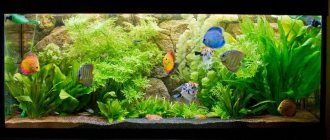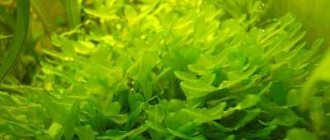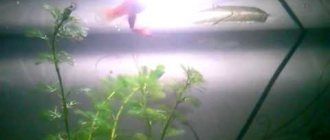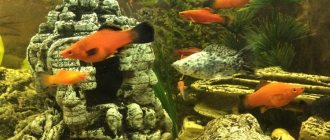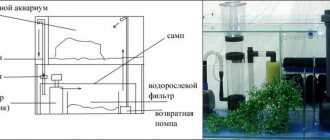Apistogramma agassizii is a small and incredibly beautiful cichlid that lives in South America. It is found over a fairly large area, from the foothills of the Andes to the confluence of the Amazon River and the Atlantic Ocean. There, the apistogram lives in both “white” and “black” water, choosing places rich in vegetation and with a slow current. The water is acidic and soft.
The large habitat of fish contributed to the emergence of geographical morphs that differ from each other in body color. White-blue fish live at the mouth of the Rio Negro, red fish live in the upper reaches of the Amazon, Peru, and Colombia, and yellow fish live in the vicinity of the cities of Santa Rema and Rio Tefe. The most common species found in home aquariums is the red Apistogramma agassica.
Fire gold "fire gold"
Range and Habitat
The fish are distributed in the narrow channels of the upper reaches of the rivers of South America, the Amazon River basin south to Bolivia and southern Brazil.
Apistogramma agassizi (Apistogramma agassizi) distribution areas.
Body color and markings can vary significantly depending on location.
Habitat
Apistogramma agassizi habitat 1.
Apistogramma agassizi (Apistogramma agassizi) habitat 2.
They typically live in slower-moving tributaries, pools and streams in areas where fallen leaves accumulate, and they can be found in black, white or clear water depending on the area or in some cases time of year. The soil in their habitat is soft.
What to feed Apistogramma Agassiz?
Like most aquarium fish, Apistogramma Agassiza will eat whatever is offered to it. Under natural conditions, it eats insects and benthic benthos. In an aquarium, they can be fed frozen or live tubifex, bloodworms, coretra, and brine shrimp. It is acceptable to use artificial substitutes.
The fish are fed two or three times a day. Portions should not be large so that uneaten leftovers do not spoil and clog the water.
Description
The body is somewhat elongated, laterally flattened. The lateral line is discontinuous, the upper part running very close to the back. The mouth is terminal. Typical are more or less clearly visible dark stripes running from the eye to the mouth and to the lower edge of the gill cover, as well as to the caudal fin. Color varies depending on the place of origin.
Apistogramma agassizi (Apistogramma agassizi) male.
In most cases, the body is blue to greenish, sometimes yellow-brown, the back is olive-brown, and the belly is yellowish-pink to orange. From the eye to the root of the tail there is a dark stripe, which may be interrupted or disappear completely. The dorsal fin is dark at the base, orange or green-blue above with a red border.
Apistogramma agassizi (Apistogramma agassizi) female.
In the male, the end of the dorsal and anal fin is much more pointed than in the female. Females are smaller than males. The male's caudal fin is spear-shaped, while the female's is rounded. While caring for the offspring, the female becomes, in most cases, yellow with deep black longitudinal stripes.
Size
The length of males is up to 8 cm, females are smaller about 5 cm.
Reproduction
Reaches sexual maturity by six months of age. They are polygamous and live in harems: one male and several females. Breeding is not difficult. Can breed in a general or spawning aquarium with a volume of 30 liters or more. Water parameters for dilution: temperature 26-27ºС, hardness 5-8º, pH 6.0-6.5. The masonry is done in a shelter, usually attached to the wall of a ceramic pot, grotto, cave. After spawning, the female guards the eggs by constantly circulating water.
The incubation period is 3 days, after which larvae appear and live in the shelter for some time. After the yolk sac resolves (this happens on days 4-6), the fry should be fed with ciliates and artemia nauplii. The female of these aquarium cichlid fish is surprisingly caring. Even at this time, she continues to monitor the offspring, controlling the movement of the flock of young animals, changing the position of her fins and body.
Behavior and Compatibility
Fish are territorial. During the period of spawning and caring for the offspring that the female produces, they become very aggressive. Each female takes over a territory around the shelter. These territories form a common territory, which is guarded by the male. But, it should be larger than the territories of all females, because otherwise, females chase the male, guarding their offspring.
Apistogramma agassizi alenquer (Apistogramma agassizi alenquer) sparring males.
When keeping several males, if the area of the aquarium is small, then fights occur between them.
Apistogramma agassizi (Apistogramma agassizi) males share territory.
Fish stay in the lower and middle layers of water. It can be kept in a common aquarium with small, very active fish that occupy the upper and middle layers of water, which will act as a hostile factor, encouraging females to protect their offspring. In some places there are thickets of plants and various shelters - caves, piles of snags, and the number of shelters should slightly exceed the number of females. A large aquarium can contain pairs of Apistogramma of different species.
Aquarium Basics
An aquarium for Apistograms should be selected at the rate of 10-20 liters per individual, and it is advisable to form a flock of one male and several females.
They prefer layers of the water column at a height of 10-15 cm from the bottom.
Environmental parameters: temperature +25…+30 °C, hardness 10-12° dgH, acidity 5.5-7.5 pH. Increased aeration and filtration are required. Weekly replacement of a third of the volume with settled water (sensitive to chlorine content).
Substrate – sand or small fractions of crumbs.
In terms of lighting, fish are unpretentious. The vegetation is dense.
Decor: driftwood, caves.
Aquarium
Basic sizes of 50 * 30 cm and more are acceptable for one pair; larger volumes are required for a group.
Content
Apistogramma agassizi aquarium biotope.
It is not difficult to maintain these apistograms. Aquarium volume from 45 liters per couple; it is desirable that it combines dense thickets of plants and free places for swimming. The number of shelters should exceed the number of fish. The optimal temperature is 25-27° C, although the temperature range that these fish can withstand is quite wide - from 22 to 29-30 degrees. In nature, this species is found in bodies of water with black, white and clear water, with a pH value of 5-7 and dGH of 0-12°.
Apistogramma agassizi fire red in aquarium 1.
When keeping and breeding, one must always take into account the territoriality of males and females protecting the offspring. According to observations, in a community aquarium, males of A. agassizii are aggressive towards other fish species, and quite actively drive anyone away from the boundaries of their territory. In addition, this species is also characterized by intraspecific aggression, and the peaceful existence of two males in a small space is simply impossible.
Water parameters
Temperature: 22 - 29° C;
pH: 5-7, commercially farmed fish are relatively unfussy, but some wild populations may require values as low as 3.0 – 4.0 to reproduce.
Hardness: 0 - 12° GH, again somewhat dependent on origin, with wild fish requiring lower values.
Apistogramma agassizi fire red in aquarium 2.
Weekly replacement of 1/10 of the volume of the aquarium not only has a beneficial effect on the general well-being of the fish, but also often stimulates spawning.
Interesting Facts
- It has been noted that the ratio of different-sex individuals in a school of fry depends on the temperature regime of the environment in which the eggs developed: in water with a higher temperature, most of the fry become males.
- The female carefully protects and takes care of them: she swallows those that have scattered around the aquarium with her mouth and spits them out into the flock with the rest.
- Clutches of young females of Agassiz apistograms are small in number and less than half are fertilized. With each subsequent spawning, the fertility of these apistograms increases.
- Young females often eat eggs and take poor care of the eggs. The “maternal instinct” of Agassiz’s apistograms is formed only over the years.
Breeding
For breeding, it is better to purchase a dozen young fish, placing them in an aquarium with optimal housing and feeding conditions for growing together. Naturally separated couples should, if possible, not be separated. To improve the conditions for fertilization of eggs, it is advisable to soften the water.
Apistogramma agassizi Tefe spawning.
Spawning both in general and in a spawning aquarium, which must be at least 15 liters for a pair, with soil, a bush of plants and a cave. The temperature is raised by 2-4° C, 1/5 of the volume of water is replaced daily with softer and more acidic water. After spawning, the male is removed. The incubation period is 3-6 days. The fry swim in 4-7 days. Starter food: live dust.
Apistogramma agassizi Tefe female with fry.
G.R. Axelrod, W. Vorderwinkler in the book “Encyclopedia of the Aquarist” describe the spawning of these apistograms as follows:
For spawning, they need a temperature of 25.5–26.5 °C (with the exception of some special cases), but in the pre-spawning period it is best to reduce it slightly, for example to 24 °C. Green the spawning area well, this will give the fish a feeling of security, put a few stones and a small flower pot, choosing the darkest corner for it. Turn the pot's neck away from the light, and perhaps the cichlids will choose this particular place for spawning. Under the pot, the male busily digs a hole in advance, spitting out all the small pieces of gravel until he manages to restore complete order. Then he chooses a female, and woe to her if she is not yet ready to spawn! Therefore, having noticed the male’s preparation for spawning, check the condition of the female, if necessary, transfer her to another aquarium and feed her properly until her abdomen is rounded, otherwise the poor fellow will get a hard time from her partner. The mature female soon allows herself to be driven to the spawning ground and lays a bunch of eggs, which the male immediately fertilizes. But as soon as the spawning is over, amazing changes happen to the female: from a modest, timid creature, she turns into a real tigress, chasing and biting her almost twice as large spouse until he takes flight. By remaining in the company of his wife at this time, he risks a lot. Left to her own devices, the female usually takes touching care of the eggs and larvae, but sometimes, especially in a very turbulent environment, she suddenly comes to the idea that this is a tasty dish and begins to eat them. Consequently, in this case, you can get a normal offspring only by artificially rearing the young. As when breeding large cichlids, the eggs are removed from the spawning tank (or the parents are removed) and a constant weak air current is connected, passing near the eggs, but not affecting them. After 4–5 days, helplessly wriggling larvae appear at the bottom. It takes another three days for them to empty their yolk sacs, then they begin to feed on ciliates or, in the worst case, powder food; after several days of the infusor diet, they begin to produce artemia nauplii. When the larvae begin to grow, everything further is not difficult; at six months of age, the fish begin to look for mates to create their own families.
Diseases of Apistogramma Agassiz
Agassiz's apistograms are very sensitive to the composition of water. It is the deterioration of the quality of the aquatic environment that causes a number of diseases of these fish. At the first unpleasant changes in the behavior of the fish, their conditions of detention should be reconsidered.
Particular attention is paid to the increase in the concentration of nitrates and organic waste in the habitat of apistograms. To prevent this, regularly siphon the soil in the aquarium and replace part of the water volume.
Infectious diseases in fish can be caused by poor-quality or spoiled live food.
You should also monitor the feeding regime of the fish. Like other cichlids, Agassiz's Apistogramma should not be overfed to prevent problems with the gastrointestinal tract. The diet of fish should be balanced and complete.
If more serious health problems occur with your fish, you should consult a specialist and begin drug treatment.
Which neighbors do they prefer?
Thanks to its peaceful nature, the butterfly will build friendly relationships with almost any fish that do not have aggression, a predatory nature, or territory ownership. Their small size and quiet lifestyle is not a signal to take action to eat their fellow creatures. Therefore, the aesthetic side of the issue requires selection according to color scheme, and the biological side - according to dietary preferences.
The apistogram is exactly the option for a home aquarium resident, where you can gain experience in caring for fish, raising offspring and observing natural instincts.
Post Views: 5,908

